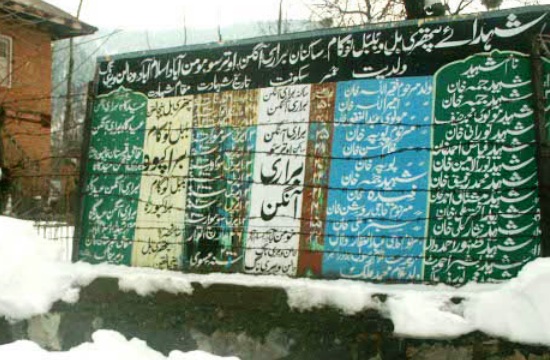Pathribal was a part of three successive and related killings which claimed 50 lives between March 20 and April 3, 2000. On March 20, unidentified gunmen killed 35 Sikhs at Chittisinghpora followed by the Pathribal killings on March 25 and then the killing of nine civilians at Brakpora on April 3 who were part of a protest over the Pathribal killings. VAKIL MANZOOR recounts.

On 25 March 2000, Indian military forces killed five men in (Vuzkhah Zontangri peak) Pathribal village of Islamabad district, claiming that the victims were “foreign militants” responsible for the attacks on Sikhs in South Kashmir’s Chittisinghpora.
Official reports claimed that security forces after a gunfight blew up the hut where the ‘militants’ were hiding, and had retrieved five bodies that had been charred beyond recognition. The bodies were buried without any postmortem examination.
Over the following days, local villagers began to protest, claiming that the men were ordinary civilians who had been killed in a fake encounter. According to them, the police between March 21 and 24 of 2000, had detained many men.
On 30 March, authorities in Anantnag relented to growing public pressure and agreed to exhume the bodies and conduct an investigation into the deaths.
On 5 April 2000, Chief Minister Farooq Abdullah ordered the exhumation of the bodies killed in Pathribal. DNA samples were collected from the 5 bodies, as well as 15 relatives of the missing young men, and were submitted to forensic laboratories in Kolkata and Hyderabad.
However, in March 2002 it was discovered that the DNA samples taken from the bodies of the Pathribal victims (all of whom were men) had been tampered with. According to reports, samples had in fact been collected from females.
Later, experts collected fresh samples in April 2002 from Kolkata and Hyderabad. That verified the five people killed in Pathribal were locals and not foreign militants as claimed by the police.
In January 2003 the case was handed to the CBI by the state government. The CBI investigation alleged that officials of 7 Rashtriya Rifles had, in fact, staged the fake encounter wherein they had killed the five innocent civilians and later on labelled them as “foreign militants”.
25-year-old youth Zahoor Ahmad Dalal was among the five persons killed. The other four civilians killed in the fake encounter included Muhammad Yousuf Malik of Halan Verinag, Bashir Ahmed Bhat of Halan Verinag, Juma Khan (son of Faqeerullah Khan) of Brari Angan and Juma Khan (son of Ameerullah Khan) of Brari Angan.
Zahoor Ahmad Dalal
For the last 10 years, the house of Raja Bano (mother of Zahoor Dalal) is locked and she is living with her brother in a nearby house. She doesn’t talk much of her son but says in a low voice. “I have kept every belonging including the clothing of Zahoor locked in almirah and each time he comes in my dreams, he asks me to donate them to poor,” says Raja.
Nazir Ahmad Dalal identified the maroon sweater and the shirt of his nephew as soon as the first grave was opened. The villagers had buried the half-burnt clothes of Dalal as well. Zahoor Ahmad Dalal was picked up just outside their home at Mominabad.
Raja Begum says, “Now the world knows we were not lying. Our stand has been vindicated. The guilt of the officials involved has been proved beyond any shade of doubt.”
Juma Khan
Roshan Jan, had no doubts left that her husband, Juma Khan was no more. “Main nay uski thudi aur nak pehchan lee (I identified his bearded, chin and nose),’’ she says. When asked whether she has any doubts left regarding the identity of her husband’s body as there is just half of the face left, she screamed, `I have lived my entire life with him, how can I make a mistake in identifying him?’’
Roshan Jan had come all the way from village Brariangan for the identification. Her son was among the eight villagers killed in the police firing upon the demonstrating villagers, who were seeking exhumation of these bodies.
She says the Army came in the night on March 24 and asked him to accompany them. They were not aggressive. They told us they wanted my husband to guide them through the hilly track. So we happily let him go. Our relative from Pathribal Moulvi Qasim identified the dead body of my father and he informed us about that. They (army) buried these dead bodies at different places.
Bashir Ahmad Bhat
A second grave was dug up at Chogam where Ghulam Rasool Bhat, whose brother Bashir Ahmad Bhat was also missing, says it was his brother’s body lying in the grave. The rest of the graves, spread over a radius of 2 to 3 km in the Pathribal area where the security forces had claimed to have killed five “foreign guerrillas” involved in the March 20 massacre of 35 Sikhs at Chittisinghpora.
He was arrested from Islamabad. He went there to collect money from the borrowers. It was 24th March, Friday. Around 7:45 pm they were arrested in the Shirpora area of Anantnag. We came to know about them only after my brother went to Islamabad on the very next morning. He asked shopkeepers about Bashir.
On 24th they were arrested and the same day they were killed and on the next morning their pictures were shown on newspaper and televisions. We staged protest for 13 consecutive days. No local was allowed to enter the graveyard. Their corpses indeed spoke how they had been tortured. We couldn’t identify them. One family recognized their son only after they saw the remaining of trousers and warmer. I recognized when I saw hand of one corpse, I shouted it is my brother.















